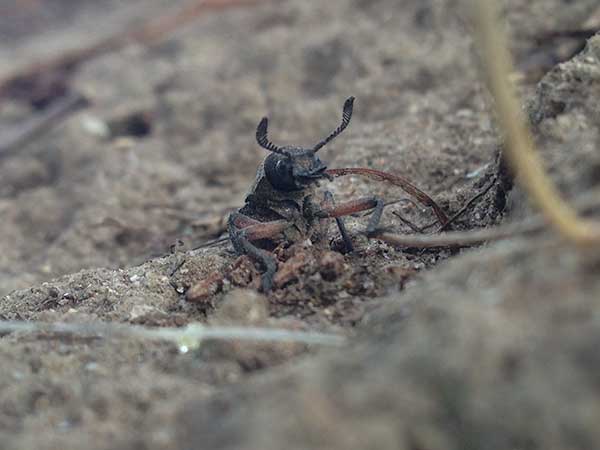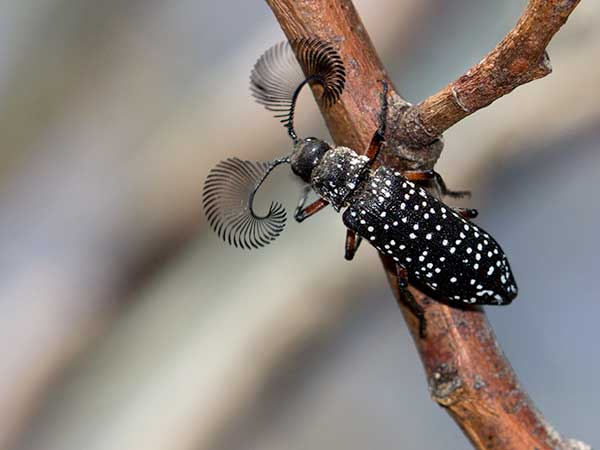Beetle mania
/Meet the stunning visitors we've had recently. These beetles are from the genus Rhipicera. Their common names include feather-horned and fan-horned beetles. Hmm, you can see why!
Photo: Wow! Those are pretty fancy looking eyelashes, I mean antennae, you have there, Mr Beetle.
An internet search revealed that little is known about these beetles' life and habits. According to a review in 2013, the Rhipicera genus contains just five species, two of which are likely to occur in our area. I think 'ours' may be Rhipicera reichei, but R. femorata is quite similar, so I'm looking to confirm that.
It's thought the males' elaborate antennae are used to detect the scent of female beetles. The females might release a pheromone when they are ready to mate. A 2015 study found male Rhipicera femorata antennae to be covered in a particular type of receptor, called the sensillum placeodeum, which researchers think are used to detect scent associated with the female beetles. By way of comparison, the elaborate male antennae were found to have approximately 30,000 such receptors per antenna, where the female antennae had just 100 each! It is also suggested Rhipicera beetles may be parasitic on cicada nymphs.
What's more, there aren't all that many sightings (for any of the Rhipicera) on the Atlas of Living Australia, and even fewer accounts of their behaviour in the papers I found. Ooh, now that sounds like an opportunity to investigate!
After a bit of watching, I've noted patterns in some of their behaviours. I think we're host to a mass emergence event of these beetles, which is pretty cool! I've observed both male and female beetles emerge from holes in the ground. They are typically most active for a couple of hours each day. That's around mid-morning until a bit into the afternoon. Generally it's the males seen flying in the air, all around the acacia trees, and a few nearby shrubs. Overall there have been quite a lot more males than females.
Photo: Female Rhipicera beetle, emerging from a hole in the ground.
Despite their distinctive appearance, the beetles are only 15-25 mm long, and remarkably well camouflaged, especially on the acacia bark. I have only seen females take short flights. Mostly those flights have been into the trees the day they emerge from the ground. Once on the tree, the females are generally seen walking, not flying, to get around. (But there were exceptions, and it is tricky to tell whether they are male or female until they land).
The males flying around the trees are looking (sorry, antennae-aided-scent-guided-searching) for females with which to mate. Their 'radar' doesn't always seem all that well-tuned. Often males flew or walked quite close to females without stopping. Other times a male spent a long time in the vicinity of the female, but seemingly couldn't see her. Or perhaps she wasn't his type?
Here's a little video of some of the activity I've been watching.
Video: Stunning Rhipicera beetles in our backyard! Alternative link https://vimeo.com/262134600, in case you can't see it above. (Turn your sound on).
I expect that the sex lives of beetles is not something you are particularly keen to know about (how did I guess?). I'll just note that at least some females mate with more than one male. Indeed, some females attracted a throng of males. After the busy flying (and mating) period, by early to mid afternoon, the beetles would take shelter and cease flying. I didn't see any re-enter the ground. The males, with their antennae overhead, remained easier to spot.
Beetles that settled on a plant overnight were generally still in the same place the following morning. But there were also quite a few 'beetle bodies' below the trees each morning; curiously, more females than males. Both the 'overnighters' above the ground and the 'new' beetles, emerging from the soil below, resumed their activities around the same time in the morning. And I don't think I saw any of them eat anything. Perhaps they spend such a short amount of time in their adult form that they don't need to eat?
It's now ten days since we first saw these beetles and this episode seems pretty much over. There are few beetles to see and nothing like the activity of last week. Now to consolidate my notes and review the specimens I've collected (have found quite a few 'bodies' without needing to kill any). Indeed, I have seen these beetles before, I even collected one at Wonga Wetlands in 2016 for an entomology subject. Interestingly, the date of that sighting was the 20th of March - right about this time of year.
I wonder when I might see them again.
POSTSCRIPT: Dr Chris Reid at the Australian Museum kindly identified these as Rhipicera femorata.
Photo: Take off reveals both the hindwings and abdomen that are usually hidden below the polka-dotted elytra.
Photo: This beetle thought it would help out my scientific efforts by walking along the ruler!
Photo: While I was watching them, beetles were often close to me or even on me. This one thought my camera was a good place from which to do her thing!
Photo: Maybe it's Maybelline!?








